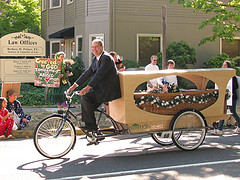- 2 reads

Dying is possibly the most natural occurrence in the world, but modern death rituals — embalming with toxic chemicals and traditional burial in concrete vaults — are not nature-friendly.
Environmentally harmful dispositions and other ecologically unfriendly practices have caused a new generation of death care professionals to green up the funeral industry with burials that tread lightly on the terrain.
Natural burial means no embalming, no elaborate casket, no burial vault — just a body returning to the earth. The concept is quite biblical if you consider the beautiful simplicity of ashes to ashes, dust to dust.
Growing Trend
A recent AARP poll asked "Which type of burial is most appealing?" Only eight percent wanted a traditional cemetery burial and only 18 percent chose cremation. Of those polled, 70.4 percent chose Green Burial.
In addition to the traditional funeral and burial, there are greener options that people are choosing for more of a natural send-off. Rather than turning their loved one over to a funeral home, some families are taking care of their loved one’s final needs at home.
Before the Civil War, families washed, dressed and laid their loved one out in the parlor where friends and family gathered for a viewing. Embalming soon became the cornerstone of death care when the Union Army needed to send slain solders back home. Americans eventually became removed from death.
When someone dies we immediately call the undertaker to "under take" all of the planning and preparation of the body. Some families are now moving away from merely passing their loved one on to a professional and are seeing the value in lovingly carrying out the preparations themselves. It is their final gift to their loved one.
Home Service
A home funeral can encompass a memorial service, wake, viewing or a combination of the three. It's also an intimate experience: friends or family members might help wash and dress the body, build or decorate a casket, plan a memorial service or accompany the deceased to the burial site or crematory.
Most states legally require only a certified death certificate, a permit giving permission to transport the body for disposition, and that the body be buried, cremated or donated to medical science.
As the baby boomer generation "slouches into retirement," they are bringing environmental consciousness and a do-it-yourself mentality to bear on end-of-life issues, said Mark Harris, author of "Grave Matters: A Journey Through the Modern Funeral Industry to a Natural Way of Burial."
"On some basic level, green burial acknowledges that the natural end of all life is decomposition and decay," Harris said. "Instead of fighting it at literally all costs with chemical embalming, concrete vaults and bulletproof metal caskets, green burial says, 'Let's just let the natural process play itself out.'"
Keep in mind that there are many shades of green. Green burial options come in many hues and are not just about saving the earth. Green burials can also help save a different kind of green — the kind found in people's wallets.
Elizabeth Fournier owns and operates Cornerstone Funeral Services in Boring, Oregon, and is known as a Green Burial Expert in Oregon, affectionately called The Green Reaper. She is the voice of the autopsy exhibit in the forensic wing at the United States National Museum of Medicine and recently published her memoir, "All Men Are Cremated Equal."

